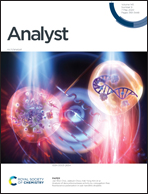The fingerprint of essential bio-oils by Fourier transform ion cyclotron resonance mass spectrometry†
Abstract
Six essential oils were analyzed by Fourier transform ion cyclotron resonance mass spectrometry coupled to negative-ion electrospray ionization (ESI(−)/FT-ICR MS). ESI offers selective ionization of a compound's polar functional groups containing nitrogen and oxygen heteroatoms. ESI in negative-ion mode allows the identification of the acidic compounds. The results showed that the samples contain between 1100–3600 individual molecular compositions, which corresponds to the greatest number of species detected to date in essential oils obtained from aromatic plant material. The compositions cover a mass range between m/z 150–500 with up to 41 carbon atoms. The dominant organic constituents of the essential oils correspond to species incorporating 2–5 oxygen atoms, detected as deprotonated/sodiated/chlorinated species. A set of 580 molecular assignments were found in common across all the samples and for the first time, a set of unique molecular systems were identified, and up to 1373 species as a unique composition for each essential oil. The molecular distributions plotted in van Krevelen diagrams (classified by their H/C vs. O/C values) suggest the presence of species with long alkyl chains and low numbers of rings plus double bonds.



 Please wait while we load your content...
Please wait while we load your content...